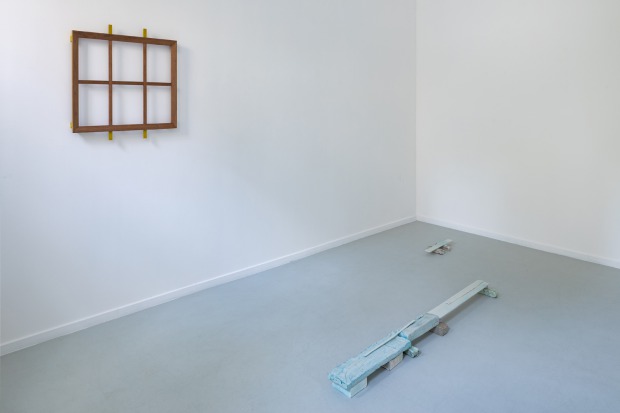 eyckgalleryartistsexhibitionsnewspublications
eyckgalleryartistsexhibitionsnewspublications
This exhibition brings together three artists whose work is created with the minimum of materials and colour. Some artworks hang or lie—almost, you might say, in anticipation of colour—others have camouflage colours or emanate such an unassuming presence that it is almost impossible to imagine that they were made by anyone at all. The works of these artists present themselves as ‘possibilities’ rather than as direct references to something.
Just as a paragraph is a smaller segment of a larger text and thus always forms the basis for what follows it, Helen Mirra’s (1970, USA) Paragrafs appear in the form of small wooden supports, entirely devoid of pretention. They are made from the timber of pallets the artist comes across on her walks, then sawn to size, painted in casein paint and partially covered with moss-coloured military blankets. They have a bucolic air, but also suggest the protective nature of shelters and, seen from a distance, become abstract compositions. With the length of her forearm and the width of her hand, her body is the measure, nature the source.
The ceramic objects of Antonietta Peeters (1969, NL) were made during her working period at the EKWC in 2018. They are modelled in porcelain or are casts of wooden planks, slats, and blocks that can be found in a painter’s studio. Peeters introduces variety by using different glazes, from glossy earth tones to a pale light turquoise. The objects can mark places on the floor or on a table. In two sculptures, they are stacked to form a delicately balanced three-dimensional work, transitional and fragile. The use of colour is deceptively unobtrusive and wholly consistent with the casual character of the object.
White Trash (Ogden) by Joe Scanlan (1961, USA) provides the basis for making a painting. We see a wooden frame, (perhaps a stretcher) from which a taut cord extends, secured by a pulley to the wall. Cloths hang from it, like laundry drying on a clothesline. The composition is held up by a wooden prop that has a woollen sock with a stone attached to it. Typical of Scanlan’s craftsmanship, laundry, woodworking, painting and textiles are shown in a single, expansive and enigmatic gesture. The orange hues of the stretcher, the length of fabric, and the pulley, are reminiscent of an orange-red pigment known as red lead or minium, a colour that Marcel Duchamp described as ‘temporary’, because it awaits the colour that will eventually coat it, like a mould.
you are free to visit us without reservation or book a timeslot if you prefer.







